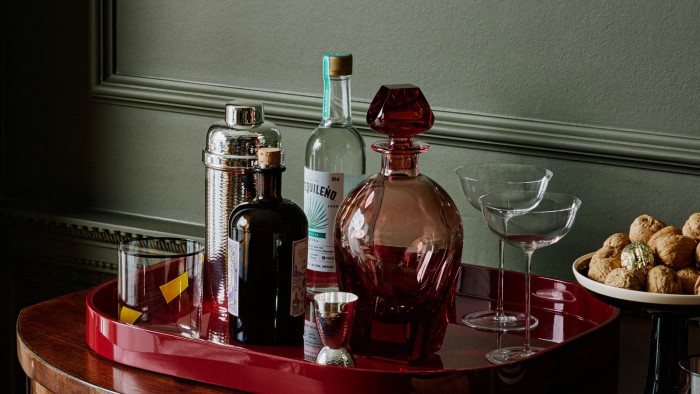How to pimp your drinks cabinet

You know it’s a special occasion when a glittering, cut-glass decanter comes out. But Robert Smith, the creative director of Bompas & Parr, a creative studio known for spectacular food and drink stunts, says the old-school accessory is increasingly at the heart of the action all year round. “There’s a renaissance in home entertaining, people are now looking to create exceptional experiences particularly around the dinner table – and the decanter really taps into that,” he says. “It’s a showpiece at the centre of the occasion. It’s not about the lonely old man having a dram at the end of the night – it’s about bringing people together.”
Bompas & Parr has developed decanter concepts for Johnnie Walker, The Macallan and Treasury Wine Estates. Adds Smith: “We’re currently working on a decanter for a tequila brand inspired by the Japanese tea ceremony.”


Casarialto Firenze jug, £105, artemest.com

Lobmeyr crystal Series B decanter, £1,030, abask.com
“I love letting a decanter take centre stage on the table,” agrees Bryony Sheridan, buying director for Abask, the online homewares boutique from former Matches executives Nicolas Pickaerts and Tom Chapman. “We recently had the joy of reviving Josef Hoffmann’s original Cubist Series B design from 1912 with Lobmeyr, reimagining the iconic black lines on the decanter in handpainted 24ct gold.” Priced at £1,030, it’s arrived just in time for Christmas.
For a splash of colour, consider Moser’s handblown crystal decanters in amethyst and amber tones. I’m also mesmerised by the orange-spouted designs by Milan-based artisans Ichendorf, and the cool, aquatic tones of the Firenze jug by Casarialto. Massimo Lunardon’s Tropical Fish decanters would light up any tablescape.
Over at vintage site 1stdibs, collectors home in on decanters “with delicate overlays of coloured glass or sterling silver”, says Anthony Barzilay Freund, editorial director. “Decanters in cut crystal, Murano glass and pieces from the art deco period also do well.” A specimen from its art deco inventory that would prove a great talking point is a 1930s tantalus featuring two clear glass flasks stabilised by a heavy oak “press” – it combines an intriguing bit of engineering with a Chanel No 5-like elegance.


Ichendorf Milano Amber decanter, £64.99, souschef.co.uk

Massimo Lunardon Tropical Fish decanter, £313, farfetch.com
Wine decanters, of course, have a job to do; they’re not just table-dressing. “There are two main reasons for decanting wine,” explains master sommelier and director of Flint Wines, Gearoid Devaney. “The first, particularly for older wines, is to separate it from the sediment. First stand the bottle upright for 24 hours and then gently pour the wine in. Younger wines, especially younger Syrahs and Tempranillos, may also benefit from a more vigorous decant to help them open up – that boost of oxygen helps to blow off any volatiles and lets more of the aromas and flavours come out.”
For big-hitting reds – particularly those in the Cabernet Sauvignon family – Devaney recommends a flat-bottomed decanter “as they give good aeration”. Two of his favourite designs are the Riedel Ultra and the Zalto Mystique. “For young white wines I’ve been enjoying the L’Universel decanter by Sydonios – it’s very elegant.”


Zalto Mystique decanter, £120, boroughkitchen.com

Riedel crystal Ultra decanter, £200
Master sommelier Stefan Neumann recommends the angular Josephinenhütte Josephine Brilliant Magnum decanter. “It looks fab, has thin but durable glass, it’s easy to clean and looks stunning.” Particularly distinctive is its conical punt, which is technically there to increase aeration, but which looks dramatic, says Neumann, “like a mountain surrounded by wine”.
If you drink a lot of whites or cooler reds, it also makes sense to have a decanter that fits in the fridge door, he adds. The fluted Mosel Performance decanter by Riedel “is great for white and red alike – I use it whenever I can”.
Sustainability is another consideration. Drinks companies are facing increasing pressure to move away from carbon-hungry, heavy glass to more low-impact packaging. “Luxury wine or whisky could be shipped in something more standardised and lightweight, such as a paper bottle or a flat, recyclable PET flask,” says Bompas & Parr’s Smith, “and then, once bought, could be decanted into something closer to a work of art.” Drinks companies that have already explored the upmarket refill include craft distillers Vault, the East London Liquor Company and super-luxe cognac Louis XIII.
@alicelascelles
#pimp #drinks #cabinet







